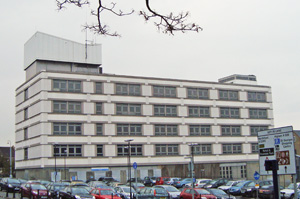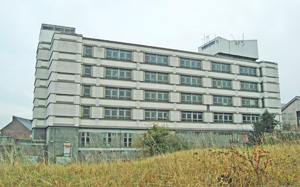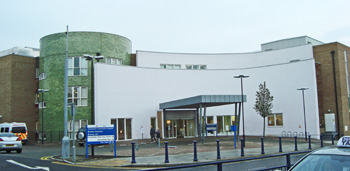Acute
The new venture was funded by several local businessmen as well as Lord Darnley, who had given 100 guineas (£105) towards its running costs.
In 1863 the Infirmary had 15 beds.
By the 1880s the Infirmary was known as the Gravesend Hospital. In 1884 the Countess of Darnley opened a children's ward.
In 1888 the Hospital was extended by the addition of two circular wards of 4 beds each; the design enabled a nurse to sit at the centre of the room and observe the patients at the periphery. The new wards were named the Russell Wards, in honour of Mrs John Russell, wife of the Gravesend brewer, who had paid for them entirely. The Hospital then had 32 beds.
In 1895 a new wing was built at a cost of £6,359. The new wards were opened by the Mayor.
In 1905 the Hospital improved and extended again. It then had 75 beds.
During WW1 (1914-1918) the Hospital was affiliated with the Chatham Military Hospital at Fort Pitt. It had 50 beds reserved for wounded servicemen, doubled to 100 by 1917 following massive casualties in France.
By the 1920s, when the Hospital had 71 beds, the facilities had become quite inadequate. A public meeting was held in 1926 to discuss the building of another extension. The projected cost of an additional block was estimated at £60,000.
On 18th July 1928 the foundation stone for the new building was laid by Mrs Raoul H. Foa. She and her husband (the President of the Hospital) had made the first donation of £1,000 to the Extension Fund.
In the same year, a new Out-Patients Department was opened by the Marquess of Carisbrooke. He returned the following year to open the new women's wards. The Hospital then had 75 beds.
The Hospital was further extended in the 1930s and, by the outbreak of war in 1939, it had 109 beds and 9 cots. It joined the Emergency Medical Service and, by 1944, had 123 beds.
In 1945, after the war, the Gravesend and District Victory Fund raised £10,000 to clear the pre-war debt on the Hospital. It also determined to raise £5,000 to provide a chapel for the Hospital (this opened in 1953, dedicated by the Bishop of Rochester).
In 1946 the Hospital had 150 beds, of which 112 were occupied on a daily basis.
By 1947 the Hospital had become dilapidated. The floors of the main corridors had become so worm that the cement floor was more visible than the rubber floor covering. During the year some of the wards were redecorated for the first time after 14 years. A new X-ray set was purchased for £3,500. On 1st October 1947 a Preliminary Training School for nurses opened at No. 67 Burch Road.
In 1947 there were 143 beds, with an average daily occupation of 113. The average weekly cost of an in-patient was £9 12s 0d (£9.60), compared to £7 4s 10d (£7.24) in 1946. The average length of stay was 19 days.
In 1948 the Hospital joined the NHS under the control of the Medway and Gravesend Hospital Management Committee, part of the South East Metropolitan Regional Hospital Board.
In 1949 the Gravesend Borough Council met with the Hospital Management Committee and the Regional Hospital Board to request that the old Sanatorium in Whitehill Lane be converted into a maternity home.
In 1965 building work began on a new block on an adjacent site to the Hospital. In 1966 a new operating theatre was installed in the main building to replace the old one.
The new wing opened in 1971. It had cost £734,000 and contained a a general medical unit and a Maternity Department with 50 beds and 6 cots in the Special Baby Care Unit.
In 1974, following a major reorganisation of the NHS, the Hospital came under the control of the Dartford and Gravesham District Health Authority of the Kent Area Health Authority, part of the South East Thames Regional Health Authority. It had 220 beds.
By 1986 the Hospital had 140 beds, but its future had become uncertain. In 1987 some 300 demonstrators gathered outside to protest against closure during a visit by Edwina Currie, then Parliamentary Under Secretary of State for Health. In 1988 a petition with 40,000 signatures was collected in support of the Hospital remaining open.
In 1989 the Hospital was refurbished at a cost of £1m. The wards and operating theatres were improved and new X-ray equipment installed. Maternity services for Dartford and Gravesend were centralised at the Hospital, and a Midwifery Education Department established.
In 1991 the catering service introduced more varied meals, taking into account the diet of ethnic minorities now part of the local population. Thus, curries and vegetarian dishes appeared on the menu, which was also translated into Urdu and Punjabi.
On 1st April 1994, following the introduction of the 'marketplace' system into the NHS, the Hospital came under the control of the Dartford and Gravesham NHS Trust. It had 192 beds.
In 1997 a Minor Injuries Unit was officially opened by Chris Pond, M.P. for Gravesham.
However, in 1999, concern grew for the future of the Hospital as building work proceeded on the new Darent Valley Hospital. A campaign began to save is as a community hospital and, in 2000, the Trust agreed to build a new facility on the Hospital site to relieve pressure on Darent Valley Hospital.
The Hospital closed in early 2004, with some services moving to the former maternity block, until that too closed in 2006.
Present status (November 2009)
The main hospital buildings were demolished in 2004 to make way for the new Gravesham Community Hospital, which opened in 2006.
The vacant maternity block remains, awaiting redevelopment.
Update: April 2016
The former maternity block is still vacant and has become derelict.

The only surviving part of the former Hospital is the 1971 maternity block in Bath Street.

The back of the building.

The site of the former Hospital is now occupied by the Gravesham Community Hospital.
(Author unstated) 1917 List of the various hospitals treating military cases in the United Kingdom. London, H.M.S.O.
http://edithsstreets.blogspot.co.uk
http://forebears.co.uk
http://hansard.millbanksystems.com (1)
http://hansard.millbanksystems.com (2)
http://hansard.millbanksystems.com (3)
www.about-gravesend.co.uk
www.bbc.co.uk
www.hospitalsdatabase.lshtm.ac.uk
www.kentonline.co.uk
www.kentvad.org
www.discovergravesham.co.uk
Return to home page